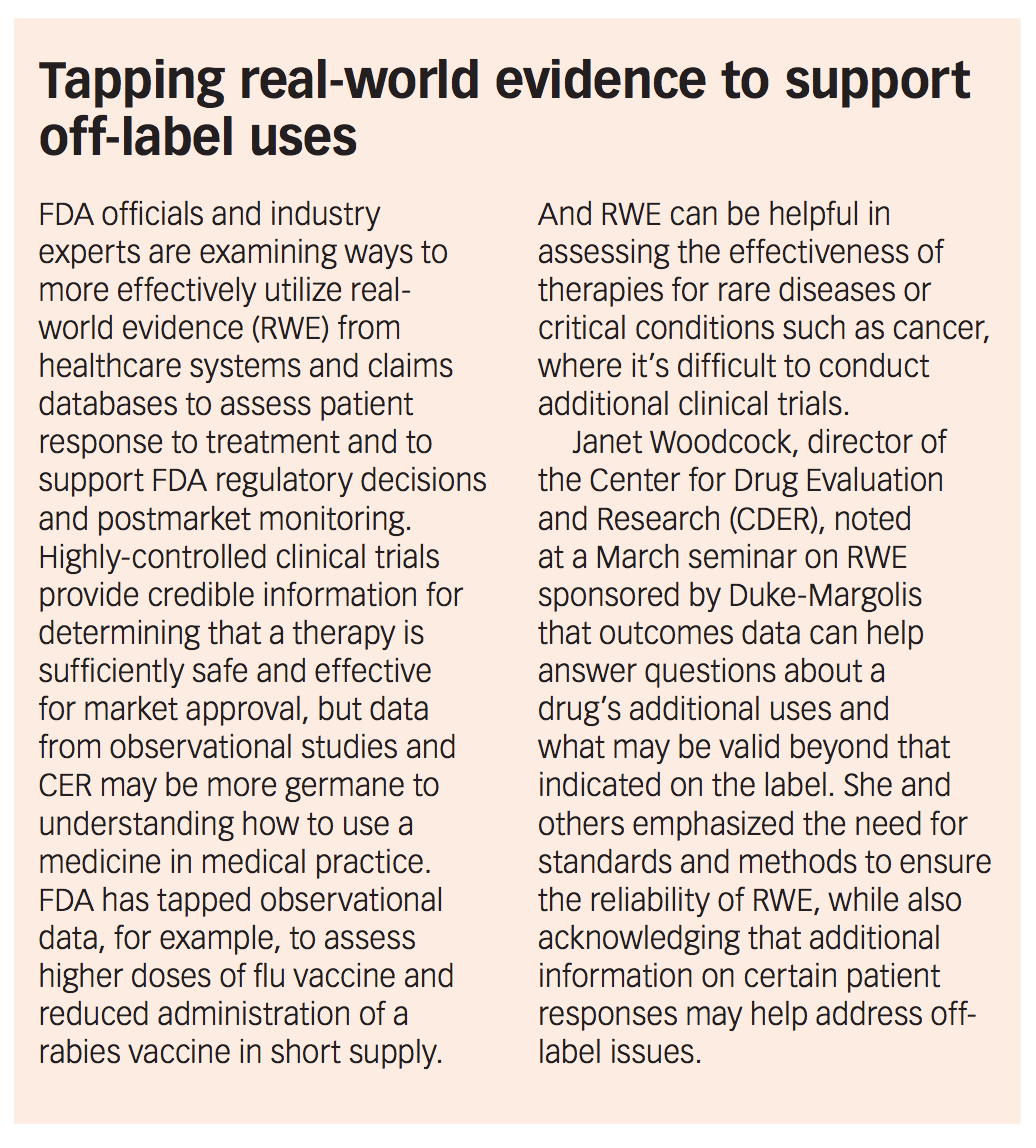Pressure Builds to Revamp Off-Label Marketing Rules
Pharmaceutical Executive
The courts, pharma, and policymakers push FDA to rethink communications policy.
Legal decisions and the Internet have altered the landscape for exchanging information on drugs and devices in the decades since FDA established its rules governing what manufacturers can say about regulated products. But the agency has not kept pace in updating its rules governing medical product promotion; FDA has yet to issue new guidance or to hold a public meeting on the subject, something that top officials said they would do more than a year ago.
The resulting inconsistent policies have led manufacturers to seek clarification
Jill Wechsler

in the courts, generating a “cycle of litigation” that diminishes FDA’s authority over communications about drugs and medical products.
FDA unofficially acknowledged its difficult situation in the March 8 settlement that permits Amarin Pharma to discuss unapproved uses of its fish-oil pill Vascepa with health professionals, so long as the information is truthful and non-misleading. FDA signaled that it will not appeal the court’s ruling in this and other similar cases, but sought to limit the impact of the agreement by stating that it is “specific to this particular case and situation” and “does not signify a position change” on the First Amendment or commercial speech.
But pharma clearly is winning the legal contest. Last December, FDA settled a complaint filed by Pacira Pharmaceuticals that permits the company to discuss the use of Exparel in a broader array of surgical procedures, including those not specifically indicated in its approved label. And just before the Amarin settlement, a federal jury in Texas decided that a medical device maker, Vascular Solutions, did not violate federal law in distributing off-label-but truthful-information on its products.
It’s not yet clear whether these court rulings will deter FDA and the Department of Justice (DoJ) from seeking further criminal misbranding charges related to a firm’s truthful, but unlabeled, speech. Legal experts advise marketers to be cautious in promoting products beyond approved indications, downplaying the prospect of a flood of unapproved marketing claims. Pharma critics, however, predict that Amarin opens the floodgates to unsubstantiated claims that will harm patients and undermine FDA regulation of prescription drugs.
What’s ‘truthful’?
A main question is how and who will determine whether a product claim is, in fact, truthful and non-misleading. The Amarin settlement sets up a process for the company to seek FDA’s opinion on future off-label messages and for settling any resulting disputes. But because FDA lacks the resources to provide such vetting to everyone, marketers are looking for other strategies to evaluate off-label communications.
A stakeholder group headed by Mark McClellan, who now directs the Duke-Margolis Center for Health Policy, issued a white paper in February on “Policy Options for Off-Label Communication,” which offers a range of proposals for addressing the off-label use landscape. It’s most contentious proposal is to establish an independent entity to accredit marketer communications. It would review company evidence associated with off-label

use and possibly set timeframes for a sponsor to develop further information to support additional indications.
The group also seeks more consistent enforcement of off-label communication policy within FDA and across federal and state agencies. A controversial idea is to authorize FDA to revise approved labeling to include information based on lower-level “tiers” of supporting evidence that could be communicated “within certain circumstances or to particular audiences.”
FDA pilot programs would test processes for adding modifications or efficacy claims to the label and for using the agency’s Sentinel System to develop evidence on new indications or to evaluate the use of unapproved claims in value-based payment models that reimburse sponsors based on impact on patient health.
Economic information
That last item reflects interest in addressing how curbs on off-label communication may limit the scope of economic information that pharma companies can provide payers and formulary committees. Marketers have long sought FDA clarification of what healthcare economic information manufacturers may share with certain knowledgeable parties, based on a policy established by section 114 of the FDA Modernization Act of 1997, which was never fully implemented.
Now the emergence of more high-cost specialty medicines, along with greater

interest in comparative effectiveness research (CER), has renewed efforts to clarify and expand 114. The House-passed 21st Century Cures legislation includes a provision that encourages the sharing of pharmacoeconomic information, and the Academy of Managed Care Pharmacy (AMCP) is spearheading an effort to develop recommendations on this topic.
Following a March meeting, a stakeholder panel organized by AMCP, which includes pharma companies, health systems, and insurers, said it would publish its report in the July issue of the AMCP Journal and also send FDA its recommendations in a format that could help the agency develop long-awaited guidance on section 114. The panel proposes to expand the range of healthcare decision-makers qualified to receive pharmacoeconomic information and to clarify that such data may be supported by “competent and reliable scientific evidence,” as opposed to the “substantial evidence” required for new drug approval.
The AMCP panel also said that patient groups should have “appropriate access” to “a full range of information about their medications”-raising the prospect of even broader dissemination of economic assessments.
Clarification of section 114 is important for marketers looking to negotiate value-based contracts with payers, a process now complicated by uncertainty about linking price and reimbursement to patient response to indications outside the approved label. Benefits and costs related to increased worker productivity or time out of the hospital may not have support from clinical trial data, but are important for health plans and PBMs.
Growing enthusiasm for value-based purchasing by all components of healthcare speaks to the need for pharma companies to be able to include wider benefits in risk-based analyses of drug use, especially for off-label uses critical to patients.
Jill Wechsler is Pharmaceutical Executive’s Washington correspondent. She can be reached at jill.wechsler@ubm.com

Pfizer, GSK Gain ACIP Recommendations for RSV and Meningococcal Vaccines
April 18th 2025The Centers for Disease Control and Prevention’s Advisory Committee on Immunization Practices voted to expand access to Pfizer’s respiratory syncytial virus vaccine Abrysvo for high-risk adults in their 50s and voted in favor of GSK’s meningococcal vaccine, Penmenvy, for streamlined adolescent protection.
Navigating Distrust: Pharma in the Age of Social Media
February 18th 2025Ian Baer, Founder and CEO of Sooth, discusses how the growing distrust in social media will impact industry marketing strategies and the relationships between pharmaceutical companies and the patients they aim to serve. He also explains dark social, how to combat misinformation, closing the trust gap, and more.